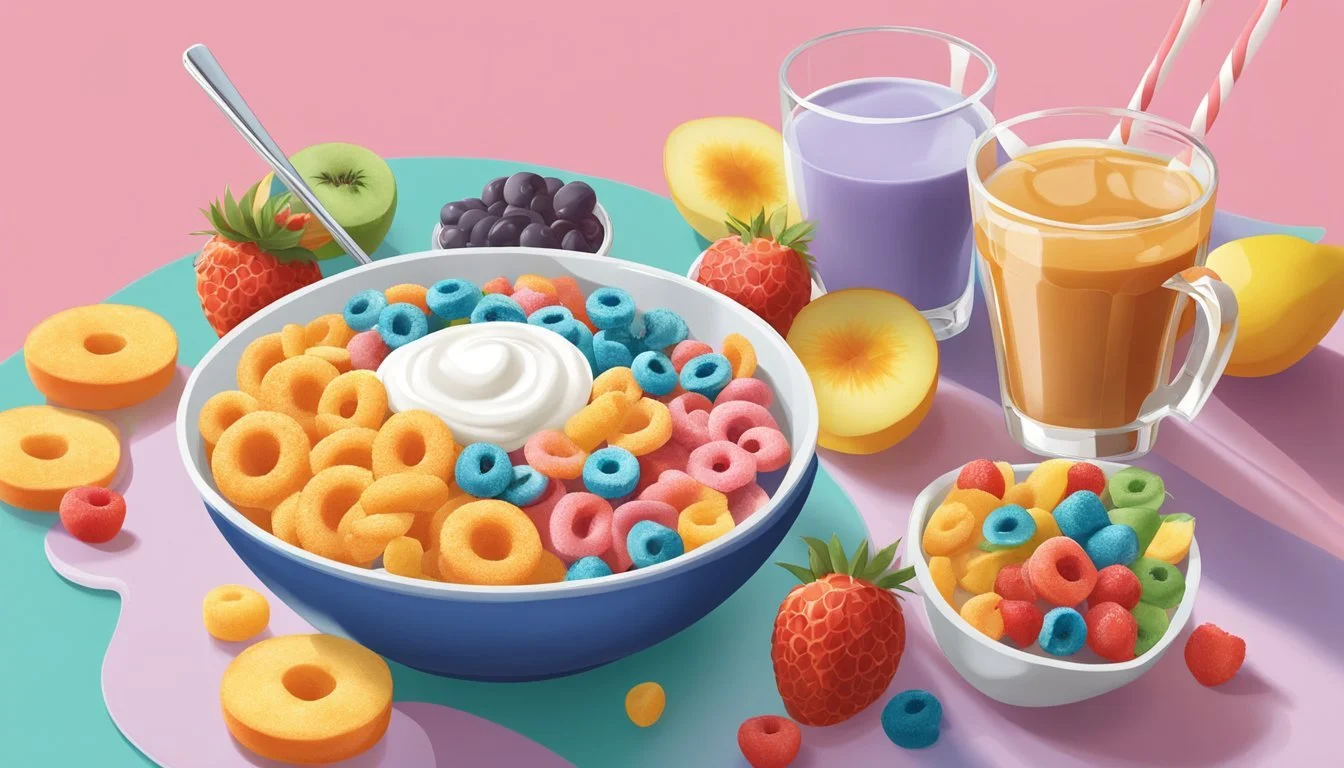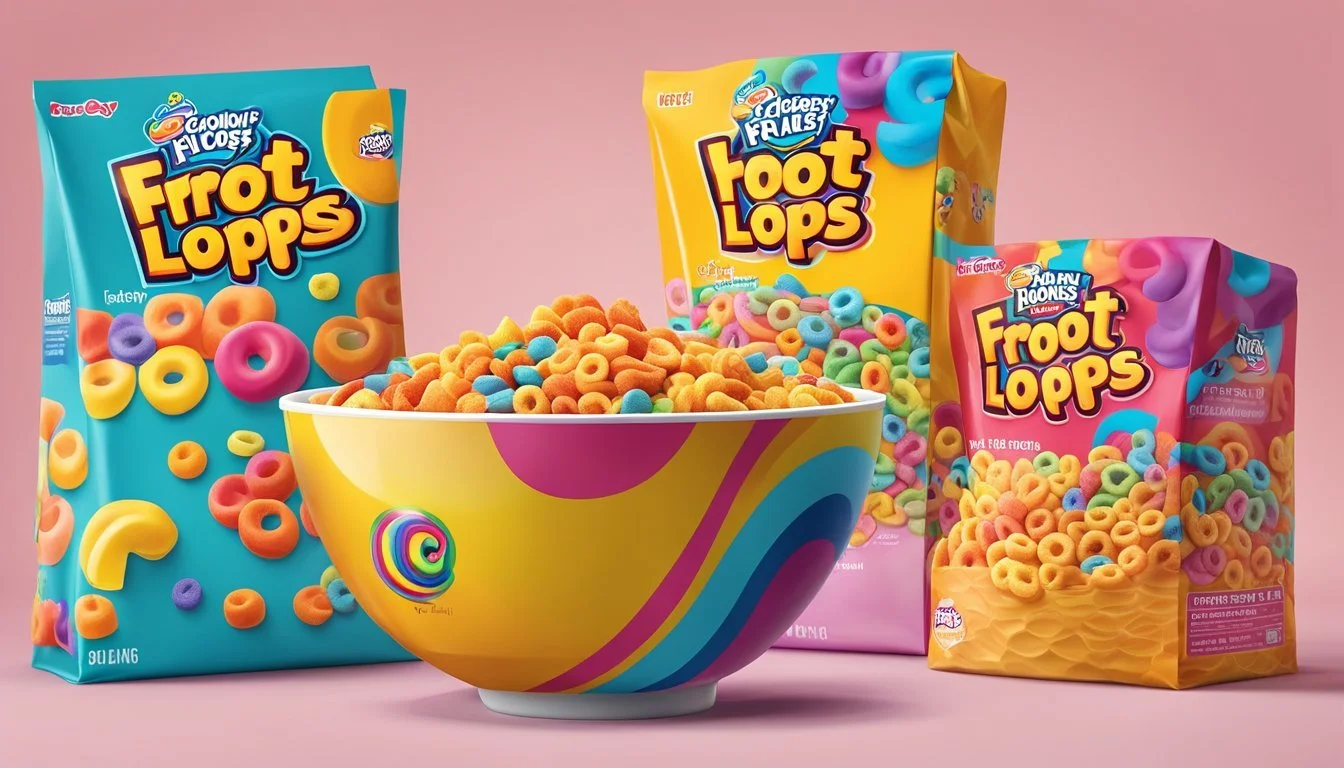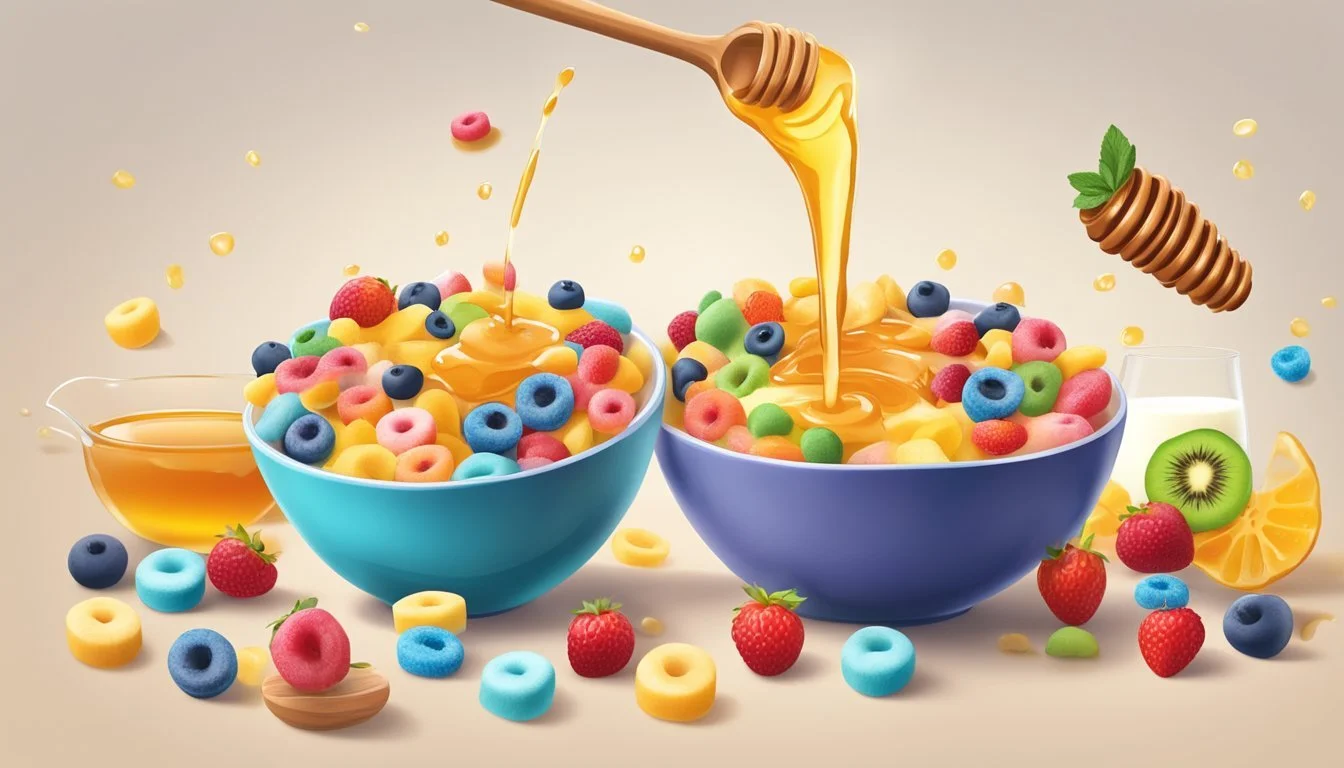Honey Ohs! vs Kellogg's Froot Loops
An In-Depth Cereal Comparison
This Article is Part of Our Breakfast Cereal Guide with Details on Honey Ohs! Nutrition and Kellogg's Froot Loops Nutrition
Honey Ohs! and Kellogg's Froot Loops are two popular contenders in the breakfast cereal aisle, each boasting its unique flavors and nutritional benefits. Consumers often wonder which of these cereals is the healthier choice for their morning meal. In terms of nutritional content, Honey Ohs! offers a higher fiber content and slightly less sugar compared to Froot Loops.
On the other hand, Kellogg's Froot Loops are fortified with essential vitamins such as Vitamin C and Zinc, which can be advantageous for those looking to boost their daily nutrient intake. Both cereals are relatively low in iron and high in carbohydrates, making them a sweet start to the day for those with a busy morning ahead.
When it comes to flavor, Honey Ohs! delivers a honey-infused taste, while Froot Loops provide a fruity and colorful experience that many find irresistible. For families with children, Froot Loops might be the go-to option due to its vibrant appeal. Both cereals have their merits, catering to different taste preferences and nutritional needs, ensuring there's something for everyone at the breakfast table.
History and Brand Overview
Honey Ohs! and Kellogg's Froot Loops each have rich histories that highlight their unique development in the cereal industry. Their brand identities have evolved over decades to appeal to various audiences.
Beginnings of Honey Ohs! and Kellogg's Froot Loops
Honey Ohs! is a cereal brand known for its honey-flavored, crunchy oat rings. Introduced by Quaker Oats in the late 1980s, it aimed to provide a sweet yet nutritious breakfast option. The cereal's unique honey-sweetened flavor and oat composition quickly garnered a loyal following.
Kellogg's Froot Loops was launched in 1959 by WK Kellogg Co. This colorful, fruit-flavored cereal was designed primarily for children, featuring a bright palette intended to attract younger consumers. The simple, sugary taste and vibrant presentation made Froot Loops an instant hit.
Evolution of Brand Identities
Honey Ohs! has maintained a consistent brand image centered around wholesomeness and natural honey. Marketing campaigns have focused on the cereal's nutritional benefits and taste. Over time, the packaging has seen minor updates, but the core brand message remains the same.
Kellogg's Froot Loops has undergone significant branding transformations, particularly with its mascot, Toucan Sam. The character and the overall aesthetic have been periodically updated to stay relevant. The brand has faced legal challenges and criticism for its ingredients, influencing some shifts towards transparency and healthfulness in recent years.
Nutritional Content Comparison
This section provides an in-depth analysis of the nutritional content of Honey Ohs! and Kellogg's Froot Loops. The analysis covers caloric values, macronutrients, sugar content, fats, and key vitamins and minerals, giving a comprehensive view of their health impacts.
Caloric Values and Serving Sizes
The caloric values and serving sizes are among the most critical factors for anyone mindful of their daily intake.
Honey Ohs! typically offers around 120 calories per 1 cup (30g) serving.
Kellogg's Froot Loops contains approximately 110 calories per 1 cup (28g) serving.
Both cereals offer similar energy levels per serving, but it's essential to measure portions accurately for proper intake.
Protein, Fiber, and Carbohydrate Breakdown
Protein, fiber, and carbohydrates are vital macronutrients that affect satiety and digestion.
Honey Ohs! contains about 2g of protein and 2g of fiber per serving. Carbohydrates stand at approximately 23g.
Kellogg's Froot Loops offers 1g of protein and 1g of fiber, with carbohydrates around 25g per serving.
Thus, Honey Ohs! has a slightly higher protein and fiber content, which can be beneficial for longer-lasting fullness.
Sugar Content and Sweeteners Used
High sugar content in breakfast cereals is a common concern.
Honey Ohs!: Each serving contains around 8g of sugar.
Kellogg's Froot Loops: It has a higher sugar content, with about 12g per serving.
Both cereals use high fructose corn syrup and other sweeteners, but Froot Loops has a notably higher sugar content which could impact blood sugar levels more significantly.
Fat Composition and Types
Understanding the types and amounts of fats can guide healthier choices.
Honey Ohs!: Contains approximately 1.5g of fat per serving, with limited saturated fat.
Kellogg's Froot Loops: Also has about 1g of fat, with a minimal amount of saturated fat.
Neither cereal contains significant amounts of monounsaturated or polyunsaturated fats, keeping their total fat content relatively low.
Vitamin and Mineral Content
Fortified cereals are important sources of essential vitamins and minerals.
Honey Ohs! is a good source of iron (10% DV), folate (25% DV), and various B vitamins such as B1, B2, B3, B6, and B12.
Kellogg's Froot Loops is enriched with similar B vitamins, iron (20% DV), and added vitamins such as A and C.
Both cereals provide essential nutrients but differ significantly in their vitamin fortifications.
Special Nutrients and Dietary Benefits
Looking beyond the basics, some cereals offer unique benefits.
Honey Ohs! provides trace minerals like manganese and copper, contributing to metabolic health.
Kellogg's Froot Loops includes additional vitamins like vitamin D and less common nutrients such as choline.
These unique nutrients play roles in various body functions, such as bone health and cognitive functions.
Both cereals offer distinct nutritional profiles with advantages and drawbacks, and the choice depends on specific dietary needs.
Dietary Considerations
Considering the nutritional content of Honey Ohs! and Kellogg's Froot Loops, one must evaluate their impact on different dietary plans such as low-fat, low-carb, low-calorie, and low glycemic index diets.
Impact on Low Fat Diets
For those following a low-fat diet, both cereals can be considered as they are not high in fat content. Honey Ohs! contains minimal fat, making it a reasonable option.
Kellogg's Froot Loops also maintain a low-fat profile. Honey Ohs! typically have around 1 gram of fat per serving, while Froot Loops usually contain about 1.5 grams per serving. Thus, both cereals fit well within the constraints of a low-fat diet.
Suitability for Low Carb Diets
Evaluating the carbohydrate content is crucial for those on a low-carb diet. Honey Ohs! contain approximately 22 grams of carbohydrates per serving, which can be considered high for low-carb strictures.
Froot Loops are similar, containing around 25 grams of carbohydrates per serving. These amounts of carbs make both options less ideal for strict low-carb diets. For individuals needing to minimize carb intake, alternative breakfast options might be more suitable.
Accommodating a Low Calorie Diet
When focusing on calorie intake, both cereals have different calorie counts. Honey Ohs! generally have around 110 calories per serving.
Froot Loops have a slightly higher calorie content, around 150 calories per serving. For those on a low-calorie diet, portion control can make either cereal a suitable choice. However, Honey Ohs! might be preferable due to its lower calorie count.
Inclusion in Low Glycemic Index Diet Plans
The glycemic index (GI) measures how food impacts blood sugar levels. Cereals high in sugars and low in fiber typically have a higher GI.
Froot Loops contain 13 grams of sugar per serving with a GI likely higher than desirable for a low-GI diet. Honey Ohs! with 1 gram of fiber and a lower sugar content might be slighter better but still not ideal for a strict low-GI plan.
In conclusion, both Honey Ohs! and Froot Loops have their strengths and weaknesses when considered across various dietary needs.
Flavor Profile and Ingredients
When comparing Honey Ohs! and Kellogg's Froot Loops, it's essential to look at their taste, ingredient quality, and use of artificial colors and flavors. These factors reveal important differences that can influence consumer preference and health considerations.
Taste Comparison
Honey Ohs! and Froot Loops offer distinct flavor experiences. Honey Ohs! have a rich honey taste that is both sweet and natural. This cereal combines crunchy oats and corn with honey, providing a robust and satisfying texture.
On the other hand, Froot Loops are known for their vibrant, fruity flavor that comes from a blend of natural fruit flavors. Despite the different colors of the cereal, their flavors are uniform, offering a consistent taste with each bite. Consumers often enjoy the fruity sweetness, which is quite different from the honey-like sweetness of Honey Ohs!.
Ingredient Quality and Sourcing
Ingredient quality is a crucial factor for consumers. Honey Ohs! prides itself on using natural flavor and ingredients that are presumably less processed compared to some of their sugary counterparts. This includes whole grain oats and corn, fortified with vitamins and minerals like folic acid.
Kellogg's Froot Loops, while also fortified with essential vitamins and minerals, utilize more processed ingredients. The primary components include refined grains and sugars. It’s important to note that the nutritional content can differ, so examining specific labels for updated information is recommended.
Presence of Artificial Colors and Flavors
Honey Ohs! maintain a more natural appearance and flavor profile, free from artificial colors and flavors. This appeals to health-conscious consumers who prefer food with fewer artificial additives.
In contrast, Froot Loops are known for their vivid colors – red 40, yellow 5, blue 1, and yellow 6 are some of the artificial colors used. These additives create the cereal's iconic colorful loops, contributing to the fun visual appeal but raising concerns for some consumers regarding artificial ingredients. The flavors in Froot Loops, while derived from a blend of fruits, rely on artificial means to achieve their distinct taste.
Consumer Perception and Market Presence
Consumers have strong opinions and associations with both Honey Ohs! and Kellogg's Froot Loops. These perceptions influence their popularity, market share, and the conversations happening on social media platforms like TikTok and YouTube.
Market Share and Popularity
Kellogg's Froot Loops is a well-established brand with a notable presence in the market. According to Kiplinger, Froot Loops contributed significantly to Kellogg's sales, generating over $269 million in the 52 weeks ending August 12. This highlights its strong market position. Credit Suisse's report mentions that Froot Loops helped Kellogg achieve solid gains in consumption and market share during the second quarter.
Honey Ohs!, on the other hand, have a more niche audience but still maintain a loyal consumer base. They are often compared to other popular cereals, such as Kellogg's Honey Smacks. This comparison underscores Honey Ohs!' competitiveness in the market. Cereal rating websites often feature consumer reviews that shed light on its appeal and areas for improvement.
Social Media Influence and Trends
Social media platforms play a crucial role in shaping consumer perceptions. TikTok and YouTube see numerous reviews, taste tests, and creative recipes featuring both cereals. Froot Loops often appear in colorful, eye-catching content that emphasizes their vibrant hues and playful branding. These videos frequently garner thousands of views, boosting Froot Loops' popularity among younger audiences.
Honey Ohs! also enjoy a presence on social media, though less pronounced. Influencers and everyday consumers share posts about their taste and versatility in various recipes. Content featuring Honey Ohs! often focuses on their unique texture and honey flavor. Social media trends have allowed Honey Ohs! to tap into a dedicated, albeit smaller, audience base that appreciates its distinct qualities.
Economic Factors
Economic indicators such as pricing and availability play a significant role in consumer choice between Honey Ohs! and Kellogg's Froot Loops. These factors affect the overall market share and consumer accessibility to these products.
Price Point and Value Analysis
Honey Ohs! generally has a competitive price range compared to Kellogg's Froot Loops. On average, a standard 12-ounce box of Honey Ohs! can be found for around $3.50, while a similar-sized box of Froot Loops typically retails for about $4.00.
Consumers often evaluate not just the direct cost, but the price per ounce and the frequency of promotions and discounts. Froot Loops often has promotional offers, which can slightly lower its price, making it more attractive during sales events.
Cost can also be influenced by packaging sizes and peripheral factors like bulk purchasing options. Both brands offer significant value through bulk packs, which reduce the cost per ounce and increase the overall value proposition.
Availability and Distribution
The availability of Honey Ohs! and Kellogg's Froot Loops varies substantially. Kellogg's Froot Loops boasts a robust distribution network, making it widely available in numerous grocery stores, big-box retailers, and even small convenience stores across various regions.
Honey Ohs!, although popular, does not have the same extensive reach. It is typically found in larger grocery chains and fewer small retail outlets, limiting its accessibility in more rural or less populated areas.
Distribution channels also affect availability. Kellogg's has more established relationships with a variety of retail outlets, ensuring consistent stock levels. Online availability for both products is strong, though Froot Loops often benefits from more prominent placement on major e-commerce platforms.
Effective distribution ensures that Kellogg's Froot Loops can reach a broader customer base more efficiently, while Honey Ohs! may experience sporadic availability, affecting consumer choices.
Packaging and Serving Suggestions
When comparing Honey Ohs! and Kellogg's Froot Loops, examining both the environmental impact of their packaging and ideal serving recommendations is crucial. This helps in making an informed choice about sustainability and how to enjoy each cereal best.
Environmental Impact of Packaging
Cereal packaging is a critical factor in sustainability. Honey Ohs! and Kellogg's Froot Loops both use recyclable cardboard boxes, which are more eco-friendly than plastic-based packaging. However, the inner plastic bags might not always be recyclable, depending on local recycling capabilities.
Kellogg's has made strides in using more sustainable packaging materials. Their goal is to create fully recyclable cereal boxes and reduce plastic usage. On the other hand, Quaker Oats, the maker of Honey Ohs!, also focuses on sustainability, aiming for 100% recyclable packaging.
Examining these efforts reveals a growing trend towards environmental responsibility in the cereal industry. Consumers can look for packaging certifications or labels that indicate recyclability.
Serving Recommendations and Pairings
Serving weight for both cereals is typically around 30 grams. Kellogg's Froot Loops contains 110 calories per serving, 2 grams of protein, 1 gram of fat, 469 milligrams of sodium, and 12 grams of sugars. Honey Ohs! offers a similar calorie content but it is advisable to check the specific nutritional label for precise figures.
Pairing these cereals with dairy or plant-based milk can enhance their nutritional profile. For example, pairing with almond milk adds healthy fats and reduces calorie intake. Adding fresh fruits like bananas or berries boosts dietary fiber and vitamins.
Serving suggestions include:
With milk: Enhances the calcium content.
Yogurt Parfait: Layers of cereal, yogurt, and fruit.
Dry Snack: Ideal for on-the-go snacking.
By considering these recommendations, one can enjoy Honey Ohs! and Froot Loops while optimizing both taste and nutritional benefits.
Nutritional and Health Claims
When comparing Honey Ohs! and Kellogg's Froot Loops, it's essential to consider their nutritional content and health marketing claims. These factors significantly impact consumer choices, especially for parents seeking healthier options for their children.
Evaluating Health Marketing Claims
Honey Ohs! promotes itself as being made with real honey, which is often associated with natural sweetness and fewer artificial additives. This cereal also aims to highlight its fiber content, appealing to those looking for a more balanced diet.
Kellogg's Froot Loops, on the other hand, markets itself based on its vibrant colors and fun shapes. It often emphasizes its vitamins and minerals content, such as providing 175% of the daily need for iron, to attract health-conscious consumers.
Comparison Table:
Attribute Honey Ohs! Froot Loops Sodium (mg) 150 469 Added Sugar (g) 10 12 Fiber (g) 3 1 Iron (% Daily Need Coverage) 20 175
Both cereals contain significant amounts of added sugar, with Froot Loops having slightly more. However, when it comes to sodium content, Froot Loops has a much higher amount compared to Honey Ohs!. Froot Loops are also significantly lower in fiber.
In terms of vitamins and minerals, Froot Loops stands out with its high iron content, covering 175% of the daily need. This can be beneficial for those who are iron deficient, though the high sugar and sodium levels may sway more health-conscious consumers towards Honey Ohs!.
More on Honey Ohs!
More on Kellogg's Froot Loops
Cinnamon Toast Crunch vs Kellogg's Froot Loops: Which is better?
French Toast Crunch vs Kellogg's Froot Loops: Which is better?
Honey Nut Cheerios vs Kellogg's Froot Loops: Which is better?
Kellogg's Apple Jacks vs Kellogg's Froot Loops: Which is better?
Kellogg's Froot Loops vs Post GrapevsNut Flakes: Which is better?
Kellogg's Froot Loops vs Post Raisin Bran Cereal: Which is better?









